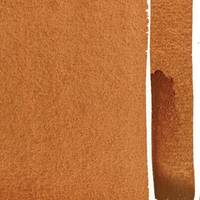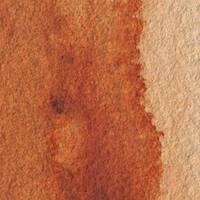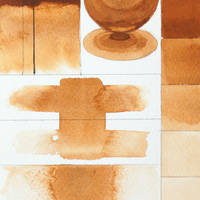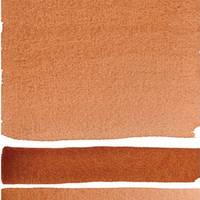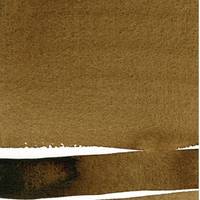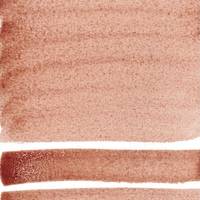Brown Iron Oxide
| CI Name | PBr7 | CI stands for "Color Index". It's a short code that easily identifies the pigment. Not all pigments have one.
|
|---|---|---|
| Toxicity | Low | The general rule of thumb to follow is to not inhale, ingest, feed to pets or babies, pour on the ground, or leave on skin. All pigments should be assumed to be dangerous, and potentially lethal if mishandled. If the pigment has high or extreme toxicity, it might be better not to use it at all. |
| Lightfastness | I | Excellent
Blue wool 7-8. The pigment will remain unchanged for more than 100 years of light exposure with proper mounting and display. (Suitable for artistic use.) |
| Transparency | O | Opaque
Opaque |
| Description | As the name suggests, Brown Iron Oxide exhibits a range of brown hues. The specific shade of brown can vary depending on factors such as the manufacturing process, particle size, and any additives or impurities present. Brown Iron Oxide pigments can range from light tans and ochres to darker, richer browns. The color is typically warm and earthy, adding a natural and organic feel to the materials it is used in. Properties: High Opacity: Brown Iron Oxide is known for its excellent opacity, meaning it can effectively cover underlying surfaces and provide good hiding power. This property makes it particularly useful in applications where full coverage is desired, such as in paints and coatings. Stability: It is a stable pigment, both chemically and thermally, which ensures its color remains consistent over time. This stability makes it suitable for use in exterior applications, as it can withstand exposure to sunlight, moisture, and other environmental factors without significant color degradation. Good Lightfastness: Brown Iron Oxide exhibits good resistance to fading when exposed to light, which is an essential characteristic for pigments used in outdoor applications or products that may be exposed to sunlight. Tinting Strength: The pigment has a reasonably high tinting strength, which means that a relatively small amount of the pigment can produce a significant color change in the material it is mixed with. This property allows for efficient coloring of various materials without the need for large pigment loadings. Chemical Inertness: Brown Iron Oxide is chemically inert, meaning it does not react with other materials, ensuring its stability and compatibility with a wide range of binders and mediums. Weather and UV Resistance: Due to its stable nature, Brown Iron Oxide is highly resistant to weathering and UV degradation, making it suitable for use in outdoor products, such as paints for building exteriors or outdoor sculptures. Versatility: The pigment's earthy brown color and properties make it suitable for a wide array of applications. It can be used in paints, coatings, plastics, ceramics, concrete, and various other materials, providing a consistent and reliable brown color. | |
| Composition | Brown Iron Oxide (PBr7) is a synthetic pigment that belongs to the group of inorganic pigments known as iron oxides. It is commonly used in various industries, including paint, coatings, plastics, and ceramics, due to its stable nature and desirable color properties. Chemically, Brown Iron Oxide is composed mainly of iron oxides and hydroxides. The specific chemical formula can vary depending on the manufacturer and the production process, but it is typically a combination of iron oxide and iron hydroxide. The primary chemical components include: 1. Iron Oxide (Fe2O3): This is the main component responsible for the brown color. Iron oxide is a naturally occurring compound that can be extracted from iron ores or synthetically produced. 2. Iron Hydroxide (Fe(OH)3): This is another key component that contributes to the brown hue. It is commonly formed as a byproduct during the production of iron oxide pigments. The exact composition may also include trace amounts of other impurities or additives, depending on the manufacturing process used. These impurities or additives can help improve the pigment's properties, such as dispersibility, opacity, and tinting strength. Brown Iron Oxide is typically available in various forms, such as powder, granules, or micronized particles, to suit different application requirements. Its color can range from light to dark brown, depending on the specific formulation and particle size distribution. Additionally, its color intensity and shade may be adjusted by varying the proportions of the iron oxide and iron hydroxide components during the manufacturing process. Overall, Brown Iron Oxide (PBr7) is a versatile and widely used pigment that provides a stable and attractive brown color in a variety of applications. | |
Paints
The following paints likely use this pigment.
Single-Pigment Watercolors
The paints listed here are not guaranteed to be single-pigment, but we found Brown Iron Oxide listed as the only known pigment in our database.
Multi-Pigment Watercolors
More Information
Information on this website related to pigments has the distict possibility of being incorrect, out of date, or baffling. It is offered for the main purpose of being able to thoughtfully compare paints based on their composition, which also might be incorrect or out of date.
Please do your own independent research about pigments if you are interested in mixing your own paints. Check out the Art is Creation Pigment Database, or handprint.
If you want to help update pigment information, or want to just share something that can be fixed, you can send an email to librarian@paintlibrary.art.
